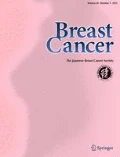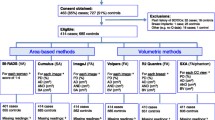Abstract
Background
The relationship between mammographic density and the risk of breast cancer was examined in Japanese women. The study was a matched case-control study comparing the mammographic densities of both breast cancer cases and healthy controls.
Materials and Methods
We selected 237 women who were diagnosed with a histologically verified breast cancer, and who underwent surgery at Gihoku General Hospital in Gifu, from January, 1998 to December, 1999. During the time of this study, 3,650 people participated in breast cancer screening with mammography and ultrasound together. We selected 742 women as a control group from the screening participants and matched them by age and the number of deliveries with the cancer patients. The same mammography machine was used for both cases and controls. For evaluation, we used a visual method (Wolfe’s classification) and a computer assisted method to classify the mammograms based on mammographic density.
Results
1 According to Wolfe’s classification, the DY group had a significantly increased breast cancer risk compared with the N1 group (Relative risk (RR) = 2.20, 95%confidence interval (95%CI) (1.02-4.77). 2 The group showing a high mammographic density had a significantly increased risk of breast cancer compared with the group with low mammographic density (RR = 2.83, 95%CI = 1.33-5.98) as classified by the computer assisted method.
Conclusion
It is suggested that women with high mammographic densities, classified visually or by computer, have an elevated risk of breast cancer compared with those with low mammographic densities.
Similar content being viewed by others
References
Boyd NF, Byng JW, Jong RA, Fishell EK, Little LE, Miller AB, Lockwood GA, Tritchler DL, Yaffe MJ: Quantitative classification of mammographic densities and breast cancer risk: results from the Canadian National Breast Screening Study.J Natl Cancer Inst 87: 670–675, 1995.
Witt I, Hansen HS, Brunner S: The risk of developing breast cancer in relation to mammography findings.Eur J Radiol 4: 65–67, 1984.
Thurfjell E, Hsieh CC, Lipworth L, Ekbom A, Adami HO, Trichopoulos D: Breast size and mammographic pattern in relation to breast cancer risk.Eur J Cancer Prev 5: 37–41, 1996.
Yaffe MJ, Boyd NF, Byng JW, Jong RA, Fishell E, Lockwood GA, Little LE, Tritchler DL: Breast cancer risk and measured mammographic density.Eur J Cancer Prev 7 Suppl 1: S47–55, 1998.
Wolfe JN: Breast patterns as an index of risk for developing breast cancer.Am J Roentgenol 126: 1130–1137, 1976.
Warner E, Lockwood G, Tritchler D, Boyd NF: The risk of breast cancer associated with mammographic parenchymal patterns: a meta-analysis of the published literature to examine the effect of method of classification.Cancer Detect Prev 16: 67–72, 1992.
Sala E, Warren R, McCann J, Duffy S, Day N, Luben R: Mammographic parenchymal patterns and mode of detection: implications for the breast screening programme.J Med Screen 5: 207–212, 1998.
Salminen TM, Saarenmaa IE, Heikkila MM, Hakama M: Risk of breast cancer and changes in mammographic parenchymal patterns over time.Acta Oncol 37: 547–551, 1998.
Byrne C, Schairer C, Wolfe J, Parekh N, Salane M, Brinton LA, Hoover R, Haile R: Mammographic features and breast cancer risk: effects with time, age, and menopause status.Natl Cancer Inst 87: 1622–1629, 1995.
Gravelle IH, Bulbrook RD, Wang DY, Allen D, Hayward JL, Bulstrode JC, Takatani OA: Comparison of mammographic parenchymal patterns in premenopausal Japanese and British women.Breast Cancer Res Treat 18 Suppl l: S93–95, 1991.
Brisson J, Morrison AS, Kopans DB, Sadowsky NL, Kalisher L, Twaddle JA, Meyer JE, Henschke CI, Cole P: Height and weight, mammographic features of breast tissue, and breast cancer risk.Am J Epidemiol 119: 371–381, 1984.
Saftlas AF, Hoover RN, Brinton LA, Szklo M, Olson DR, Salane M, Wolfe JN: Mammographic densities and risk of breast cancer.Cancer 67: 2833–2838, 1991.
Boyd NF, O’Sullivan B, Campbell JE, Fishell E, Simor I, Cooke G, Germanson T: Mammographic signs as risk factors for breast cancer.Br J Cancer 45: 185–193, 1982.
Gertraud M, Lixin M: A case-control study of mammographic densities in Hawaii.Breast Cancer Res Treat 63: 153–161, 2000.
Morimoto T, Sasa M, Yamaguchi T, Kondo H, Akaiwa H, Sagara Y: Breast cancer screening by mammography in women aged under 50 years in Japan.Anticancer Res 20: 3689–3694, 2000.
Day N, Warren R: Mammographic screening and mammographic patterns.Breast Cancer Res 2: 247–251, 2000.
Author information
Authors and Affiliations
Corresponding author
Additional information
Reprint requests to Yasuko Nagao, 2nd Department of Surgery, Gifu University School of Medicine Department of Surgery, 40 Tsukasa-machi, Gifu 500-8705, Japan.
About this article
Cite this article
Nagao, Y., Kawaguchi, Y., Sugiyama, Y. et al. Relationship between mammographic density and the risk of breast cancer in japanese women: a case-control study. Breast Cancer 10, 228–233 (2003). https://doi.org/10.1007/BF02966722
Received:
Accepted:
Issue Date:
DOI: https://doi.org/10.1007/BF02966722




